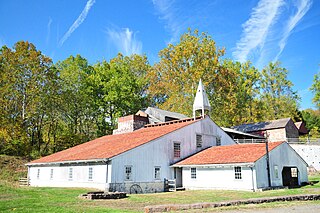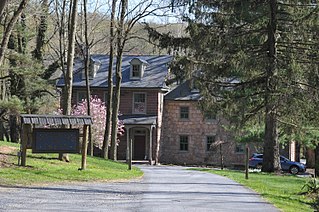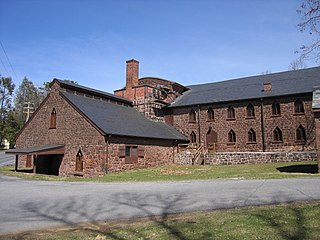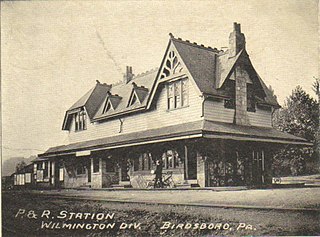
Birdsboro is a borough in Berks County, Pennsylvania, United States. Located along the Schuylkill River, it is 8 miles (13 km) southeast of Reading. As of the 2010 census, it had a population of 5,163. In the past, Birdsboro was noted for its large foundries and machine shops, none of which remain in operation today.

The Bethlehem Steel Corporation was an American steelmaking company headquartered in Bethlehem, Pennsylvania. For most of the 20th century, it was one of the world's largest steel producing and shipbuilding companies. At the height of its success and productivity, the company was a symbol of American manufacturing leadership in the world, and its decline and ultimate liquidation in the late 20th century is similarly cited as an example of America's diminished manufacturing leadership. From its founding in 1857 through its 2003 dissolution, Bethlehem Steel's headquarters and primary steel mill manufacturing facilities were based in Bethlehem, Pennsylvania in the Lehigh Valley region of the United States.

An ironworks or iron works is an industrial plant where iron is smelted and where heavy iron and steel products are made. The term is both singular and plural, i.e. the singular of ironworks is ironworks.

Hopewell Furnace National Historic Site in southeastern Berks County, near Elverson, Pennsylvania, is an example of an American 19th century rural "iron plantation," whose operations were based around a charcoal-fired cold-blast iron blast furnace. The significant restored structures include the furnace group (blast furnace, water wheel, blast machinery, cast house and charcoal house), as well as the ironmaster's house, a company store, the blacksmith's shop, a barn and several worker's houses.

Speedwell Forge Mansion, also known as Speedwell Forge Homestead, is a historic home located at Elizabeth Township, Lancaster County, Pennsylvania. The ironmaster's mansion was built about 1760, and is a 2½-story, four bay wide and two bay deep, brownstone and fieldstone dwelling in the Georgian style. It was expanded about 1795 with a Georgian/Federal style wing. Also on the property are a contributing stone summer kitchen, stone and frame workshop, stone paymaster's office c. 1795), and stone privy.

The Phoenix Iron Works, located in Phoenixville, Pennsylvania, was a manufacturer of iron and related products during the 19th century and early 20th century. Phoenix Iron Company was a major producer of cannons for the Union Army during the American Civil War. The company also produced the Phoenix column, an advance in construction material. Company facilities are a core component of the Phoenixville Historic District, a National Register of Historic Places site that was in 2006 recognized as a historic landmark by ASM International.
The Georges Creek Coal and Iron Company is a defunct coal mining, iron producer and railroad company that operated in Maryland from 1835 to 1863.

Cornwall Iron Furnace is a designated National Historic Landmark that is administered by the Pennsylvania Historical and Museum Commission in Cornwall, Lebanon County, Pennsylvania in the United States. The furnace was a leading Pennsylvania iron producer from 1742 until it was shut down in 1883. The furnaces, support buildings and surrounding community have been preserved as a historical site and museum, providing a glimpse into Lebanon County's industrial past. The site is the only intact charcoal-burning iron blast furnace in its original plantation in the western hemisphere. Established by Peter Grubb in 1742, Cornwall Furnace was operated during the Revolution by his sons Curtis and Peter Jr. who were major arms providers to George Washington. Robert Coleman acquired Cornwall Furnace after the Revolution and became Pennsylvania's first millionaire. Ownership of the furnace and its surroundings was transferred to the Commonwealth of Pennsylvania in 1932.
TrentonWorks is an industrial manufacturing facility located in the town of Trenton, Nova Scotia, Canada.

The Coventryville Historic District is a historic district and historic village in Chester County, Pennsylvania that occupied a significant role in the early American metal industry.
The Grubb Family Iron Dynasty was a succession of iron manufacturing enterprises owned and operated by Grubb family members for more than 165 years. Collectively, they were Pennsylvania's leading iron manufacturer between 1840 and 1870.

St. Michael's Episcopal Church, Parish House and Rectory is a group of architecturally-significant religious buildings located at 200-216 North Mill Street in Birdsboro, Berks County, Pennsylvania. It was added to the U.S. National Register of Historic Places in 1982.

Isabella Furnace was a cold blast charcoal iron furnace located in West Nantmeal Township, Chester County, Pennsylvania. The furnace was named for Isabella Potts, wife of one of the partners, a member of the Potts ironmaking family. Isabella was the last iron furnace to be built in the county, in 1835, and was operated by members of the Potts family and their partners until 1855, when they lost control of it in a bankruptcy. It returned to the family in 1881, when it was purchased by Col. Joseph Potts, who modernized it. The furnace, the last to operate in Chester County, went out of blast in 1894, a few months after Col. Potts' death, but remained largely intact until after his son's death in 1943. The remains of the furnace complex have been listed in the National Register of Historic Places since 1991.
Mesta Machinery was a leading industrial machinery manufacturer based in the Pittsburgh area town of West Homestead, Pennsylvania. It was founded in 1898 by George Mesta when he merged his machine shop with another. Mesta "machines" can be found in factories throughout the world and as of 1984 had equipment in 500 steel mills. Mesta was the 488th largest American company in 1958 and the 414th largest in 1959.
The Bourne-Fuller Company in Cleveland, Ohio, was one of three constituent companies that formed the Republic Steel Corporation in 1930. The other companies were the Central Alloy Company and Republic Iron and Steel Company. The principal stockholder of Republic was Cyrus Eaton, a well-known financier who made a fortune, in part, through Republic Steel.

The Reading Company used two passenger railway stations in or near Birdsboro, Pennsylvania. The Philadelphia and Reading Railroad built a station on its Main Line in Exeter Township, on the opposite side of the Schuylkill River from Birdsboro. The Wilmington and Northern Railroad established a freight line to Birdsboro in 1870, but it was not until after its merger with the Reading Company that its passenger station was built in the borough.
Curran Steels was a manufacturing company in Cardiff, Wales, founded as the Edward Curran Engineering Co and known locally as Curran's.

The Société des aciéries de Longwy was a steelworks located in Longwy, Meurthe-et-Moselle, France.

The Edward Brooke II Mansion (1887–88), also known as "Brookeholm," is a Queen Anne country house at 301 Washington Street in Birdsboro, Pennsylvania. Designed by architect Frank Furness and completed in 1888, it was Edward Brooke II's wedding present to his bride, Anne Louise Clingan.
The Eureka Iron & Steel Works was an American iron and steel company in Wyandotte, Michigan. It started in 1853 with the discovery of unusually high-quality iron ore in the Upper Peninsula of Michigan. A group of businessmen in the Detroit area figured this could be a profitable enterprise to manufacture iron and steel, so they pooled together funds to form a new company. The company produced the first commercially available steel in America. One of the first uses for this steel was tracks for railroads. It was in business until 1892.














